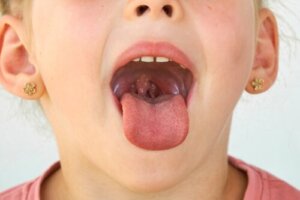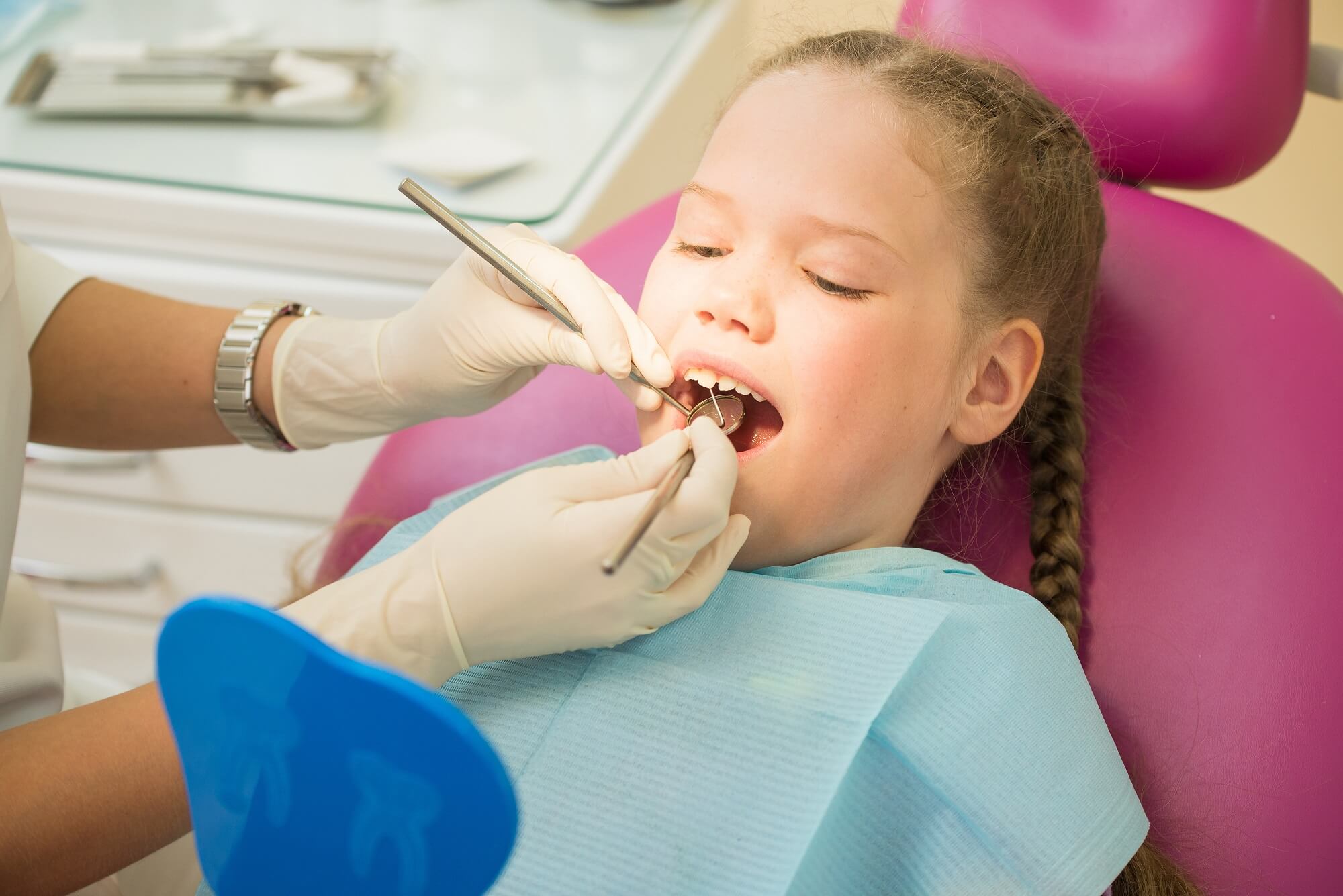How Saliva Influences Children's Teeth


Written and verified by the dentist Vanesa Evangelina Buffa
Moisture is one of the most notorious characteristics of the oral cavity. Saliva is responsible for keeping the teeth, tongue, and other structures in children’s mouths wet to facilitate their functions. Keep reading to learn how saliva influences children’s teeth.
In the first months of the baby’s life, the salivary glands complete their development and saliva production becomes evident. Drooling in children is one of the manifestations of the correct secretion of this fluid. On average, adults produce about 1 liter of saliva per day. In children, this amount can reach up to 1 and a half liters per day. As we’ll tell you in the article below, the presence of this liquid in the mouth is very beneficial.
Children and saliva
Saliva is a clear liquid that’s mostly composed of water. It also contains electrolytes, mucus, antibacterial elements, and enzymes. It’s produced by the major salivary glands–the parotid, sublingual and submaxillary glands–and by the smaller glands that are scattered on the mucous membrane of the lips and palate.
This fluid that humans secrete constantly and naturally is essential for the correct functioning of the mouth. The highest production occurs before, during, and after meals. It reaches its peak at midday and decreases considerably at night, during sleep.
Saliva’s involved in many physiological processes, such as digestion and speech. At the same time, it helps maintain oral and general health. Let’s look at its functions in detail.

Saliva functions
Saliva lubricates and keeps the mouth, mucous membranes, and teeth moist, thus helping in the swallowing of food. Learn about this and other functions of saliva in the oral cavity of children:
- It moistens the food and helps form the food bolus to facilitate swallowing. In addition, the enzymes that it contains begin the digestive process by breaking down food before it reaches the stomach.
- It allows us to taste the different flavors of food. If the mouth didn’t have enough moisture, the tongue wouldn’t be able to perceive the different tastes of food.
- It acts as a self-cleaning mechanism that sweeps away debris to maintain oral hygiene.
- It reduces the harmful effect of bacteria through its self-cleaning mechanism and its buffering capacity, which counteracts and neutralizes the oral environment when it becomes too acidic or too alkaline. In this way, it helps to prevent caries.
- It’s capable of providing calcium and fluoride to children’s teeth. These remineralizing properties help to strengthen and care for the enamel for a longer period of time.
How saliva influences children’s teeth
Saliva plays a fundamental role in oral health and the well-being of children’s teeth. Its antibacterial properties and its rinsing and cleansing effects help to keep teeth free of debris.
In addition, saliva influences children’s teeth thanks to its ability to neutralize acids produced by bacteria. What0’s more, its remineralizing effects play a defensive role in reducing the risk of caries. However, if this fluid decreases, the protection disappears, and the risk of diseases in the mouth increases.
The appearance of caries in children
In general, children who sleep with their mouths open or who are oral breathers have more cavities than those who breathe through the nose. In these cases, the upper incisors are exposed to the outside air, dry out, and bacterial plaque remains adhered to their surface, as saliva can’t perform its cleansing function.
Children who don’t have space between their teeth are also much more prone to cavities. In this case, it’s because saliva can’t flow and clean the interproximal area.
Children who suffer from certain diseases, such as asthma, bronchitis, or emphysema; or who use certain medications, such as corticoids or bronchodilators, may suffer changes in the composition or quantity of their saliva. This effect also increases the risk of cavities. In these cases, it’s essential to take care of oral hygiene to counteract the absence of salivary protection.

How to know if your child has enough saliva
Most children produce the right amount of saliva naturally. For this to occur, hydration and a balanced diet are essential. However, some children may suffer from dry mouth as a result of habits, health conditions, or medication. These are some of the symptoms that will help you identify dry mouth in your little one:
- Very sticky or dense saliva
- Dry and cracked lips
- Pain in the corners of the mouth when opening the mouth
- Dry, cracked, and rough tongue
- Difficulty chewing, swallowing, tasting, and speaking
- A continuous sensation of thirst
How to increase saliva production to protect children’s teeth
Saliva is a fundamental element for taking care of children’s teeth and oral health. Now that you’re aware of how saliva influences children’s teether, here are some tips to help your child have adequate saliva production:
- Chewing food: Giving children food in pieces to chew promotes salivary production.
- Chewing sugarless gum: As long as the child knows how to chew gum safely, these products can be offered from time to time to promote salivary production.
- Adequate hydration: Offering plenty of water to your little ones keeps them hydrated and with the necessary amount of liquids for adequate salivary secretion. It’s important for them to ingest between 1.5 and 2 liters of water daily (6 to 8 glasses).
These recommendations don’t replace oral hygiene habits, but complement mouth care. With adequate saliva production, plus regular oral care, your child’s teeth will be protected against cavities.
Moisture is one of the most notorious characteristics of the oral cavity. Saliva is responsible for keeping the teeth, tongue, and other structures in children’s mouths wet to facilitate their functions. Keep reading to learn how saliva influences children’s teeth.
In the first months of the baby’s life, the salivary glands complete their development and saliva production becomes evident. Drooling in children is one of the manifestations of the correct secretion of this fluid. On average, adults produce about 1 liter of saliva per day. In children, this amount can reach up to 1 and a half liters per day. As we’ll tell you in the article below, the presence of this liquid in the mouth is very beneficial.
Children and saliva
Saliva is a clear liquid that’s mostly composed of water. It also contains electrolytes, mucus, antibacterial elements, and enzymes. It’s produced by the major salivary glands–the parotid, sublingual and submaxillary glands–and by the smaller glands that are scattered on the mucous membrane of the lips and palate.
This fluid that humans secrete constantly and naturally is essential for the correct functioning of the mouth. The highest production occurs before, during, and after meals. It reaches its peak at midday and decreases considerably at night, during sleep.
Saliva’s involved in many physiological processes, such as digestion and speech. At the same time, it helps maintain oral and general health. Let’s look at its functions in detail.

Saliva functions
Saliva lubricates and keeps the mouth, mucous membranes, and teeth moist, thus helping in the swallowing of food. Learn about this and other functions of saliva in the oral cavity of children:
- It moistens the food and helps form the food bolus to facilitate swallowing. In addition, the enzymes that it contains begin the digestive process by breaking down food before it reaches the stomach.
- It allows us to taste the different flavors of food. If the mouth didn’t have enough moisture, the tongue wouldn’t be able to perceive the different tastes of food.
- It acts as a self-cleaning mechanism that sweeps away debris to maintain oral hygiene.
- It reduces the harmful effect of bacteria through its self-cleaning mechanism and its buffering capacity, which counteracts and neutralizes the oral environment when it becomes too acidic or too alkaline. In this way, it helps to prevent caries.
- It’s capable of providing calcium and fluoride to children’s teeth. These remineralizing properties help to strengthen and care for the enamel for a longer period of time.
How saliva influences children’s teeth
Saliva plays a fundamental role in oral health and the well-being of children’s teeth. Its antibacterial properties and its rinsing and cleansing effects help to keep teeth free of debris.
In addition, saliva influences children’s teeth thanks to its ability to neutralize acids produced by bacteria. What0’s more, its remineralizing effects play a defensive role in reducing the risk of caries. However, if this fluid decreases, the protection disappears, and the risk of diseases in the mouth increases.
The appearance of caries in children
In general, children who sleep with their mouths open or who are oral breathers have more cavities than those who breathe through the nose. In these cases, the upper incisors are exposed to the outside air, dry out, and bacterial plaque remains adhered to their surface, as saliva can’t perform its cleansing function.
Children who don’t have space between their teeth are also much more prone to cavities. In this case, it’s because saliva can’t flow and clean the interproximal area.
Children who suffer from certain diseases, such as asthma, bronchitis, or emphysema; or who use certain medications, such as corticoids or bronchodilators, may suffer changes in the composition or quantity of their saliva. This effect also increases the risk of cavities. In these cases, it’s essential to take care of oral hygiene to counteract the absence of salivary protection.

How to know if your child has enough saliva
Most children produce the right amount of saliva naturally. For this to occur, hydration and a balanced diet are essential. However, some children may suffer from dry mouth as a result of habits, health conditions, or medication. These are some of the symptoms that will help you identify dry mouth in your little one:
- Very sticky or dense saliva
- Dry and cracked lips
- Pain in the corners of the mouth when opening the mouth
- Dry, cracked, and rough tongue
- Difficulty chewing, swallowing, tasting, and speaking
- A continuous sensation of thirst
How to increase saliva production to protect children’s teeth
Saliva is a fundamental element for taking care of children’s teeth and oral health. Now that you’re aware of how saliva influences children’s teether, here are some tips to help your child have adequate saliva production:
- Chewing food: Giving children food in pieces to chew promotes salivary production.
- Chewing sugarless gum: As long as the child knows how to chew gum safely, these products can be offered from time to time to promote salivary production.
- Adequate hydration: Offering plenty of water to your little ones keeps them hydrated and with the necessary amount of liquids for adequate salivary secretion. It’s important for them to ingest between 1.5 and 2 liters of water daily (6 to 8 glasses).
These recommendations don’t replace oral hygiene habits, but complement mouth care. With adequate saliva production, plus regular oral care, your child’s teeth will be protected against cavities.
All cited sources were thoroughly reviewed by our team to ensure their quality, reliability, currency, and validity. The bibliography of this article was considered reliable and of academic or scientific accuracy.
- MORALES-CHÁVEZ, M. A. R. I. A. N. A. (2020). El rol de la saliva en el riesgo de caries en pacientes pediátricos con autismo. Revisión de la literatura. Odontología Pediátrica, 28(2), 84-91.
- Sáenz Masís, M. F., & Madrigal López, D. (2019). Capacidad buffer de la saliva y su relación con la prevalencia de caries, con la ingesta de diferentes bebidas comerciales. Odontología Vital, (31), 59-66.
- Gargantini, P., & Joison, A. (2019). Estudio del pH y niveles de flúor en saliva y placa dental en niños con dentición permanente temporaria y mixta. Revista Methodo, 4(3).
- Tan, T. M., Arango, E. L., & Labarcena, B. R. (2019). Características del esmalte y rol de la saliva como factores de riesgo a caries dental. Progaleno, 2(3), 224-235.
- Lluman Guapi, D. S. (2020). Formación de caries relacionado con la dieta y PH salival en pacientes pediátricos de 5 a 10 años (Bachelor’s thesis, Universidad de Guayaquil. Facultad Piloto de Odontología).
- Escalona, T. P., Ortiz, H. R. C., Palomino, Y. P., Tamayo, M. I., & Rodríguez, M. I. R. (2015). Relación entre factores de riesgos y caries dental. Multimed, 19(4), 1-13.
- Santiago-Lagunes, L. M., Ríos-Gallardo, P. T., Perea-Martínez, A., Lara-Campos, A. G., González-Valadez, A. L., García-Osorio, V., … & Reyes-Gómez, U. (2020). Importancia de una hidratación adecuada en niños y adolescentes. Salud Quintana Roo, 11(39), 27-30.
- Cabrera Chaguala, J. P., Calderón Moreno, J. S., Jiménez Rodríguez, M. F., & Riveros Gallo, Y. K. (2021). Relación entre los medicamentos antiasmáticos y el desarrollo de caries dental en niños y adolescentes. Revisión sistemática.
This text is provided for informational purposes only and does not replace consultation with a professional. If in doubt, consult your specialist.








